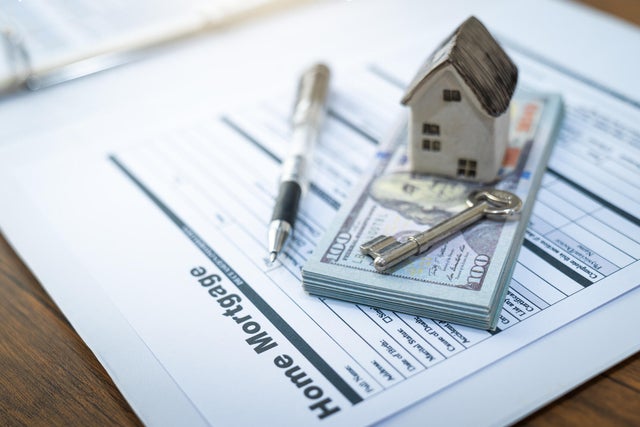What are the monthly payments on a $550,000 mortgage now that rates have dropped?
The mortgage loan rates you're offered in today's borrowing landscape could be dramatically different today than they were just a few months ago. After all, the Federal Reserve conducted its first official rate cut of 2025 late last month, and that had a big impact on mortgage rates. While the Fed's rate decisions don't directly impact mortgage rates, the rate drop that occurred before the central bank's September rate cut put homeownership back within reach for many potential buyers who'd been priced out.
Right now, the average 30-year fixed mortgage rate is sitting at an average of 6.34%, down from nearly 7% in January 2025. And, last month's mortgage rate drop caused 15-year mortgage loans to also become more affordable, with 15-year mortgage loans averaging 5.64% currently, down from an average of 6.14% at the start of the year. That may not seem substantial on paper, but a rate drop that significant can lead to big savings.
For anyone looking at homes in the $550,000 range — a price point that's become standard in metros across the nation — the monthly payment difference between rates then and now is hardly trivial. For some buyers, today's lower monthly mortgage payments could even mean the difference between qualifying for a loan or being denied. Before you take out a loan, though, you need to understand what your payments would be in this lower-rate environment.
Find out how low your mortgage payments could be in today's rate landscape.
What are the monthly payments on a $550,000 mortgage now that rates have dropped?
Today's mortgage rates are substantially lower than they were at the start of this year, and that difference shows up clearly in your monthly payment. With the current average 30-year mortgage rate at 6.34%, a $550,000 loan would cost you $3,418.70 per month in principal and interest. That's $214.64 less per month compared to the same loan at the average January 2025 rate of 6.93%, which would have carried a payment of $3,633.34 per month.
If you're considering a 15-year mortgage instead, the savings could be equally significant. At today's average 15-year rate of 5.64%, your payment on a $550,000 mortgage loan would be $4,534.92 each month. Back in January, when 15-year mortgage loan rates averaged 6.14%, that same loan would have cost you $4,682.92 monthly, meaning you'd save roughly $148 per month at current rates.
The choice between a 15-year and 30-year mortgage involves trade-offs beyond just the monthly payment, though. While the 15-year mortgage loan option at $4,534.92 per month is over $1,100 more expensive each month than the 30-year loan, you'll pay off your home in half the time and save substantially on interest over the life of the loan. The 30-year mortgage, on the other hand, offers more breathing room in your monthly budget and can be the better choice if you plan to invest the difference or need more financial flexibility.
It's worth noting that these figures cover only principal and interest. Your actual monthly housing payment will be higher once you factor in property taxes, homeowners insurance and private mortgage insurance (PMI) if you're putting down less than 20%. Still, the recent mortgage rate drop creates meaningful savings that directly reduce your monthly obligation.
Learn more about your mortgage loan options and find the right fit now.
How much would it cost to refinance a $550,000 mortgage at today's lower rates?
If you currently have a $550,000 mortgage that you took out at a higher rate earlier this year (or prior), refinancing your mortgage loan could put extra money back in your pocket each month. Today's average 30-year refinance rate sits at 6.64%, which would give you a payment of $3,527.17 per month on a $550,000 mortgage loan. That's a savings of about $106.18 monthly, or about $1,274 per year, compared to when rates averaged 6.93% in January 2025. At that rate, your payments would have been about $3,633.34 per month.
For homeowners with 15-year mortgages, the refinancing math works similarly. Current 15-year mortgage loan refinance rates are averaging 6.01%, which translates to a monthly payment of $4,644.18 on a $550,000 loan. When compared to the average 6.14% rate in January 2025, when the monthly payments were $4,682.92, you'd save about $38.74 per month, or roughly $465 annually, by refinancing at today's rates.
Before rushing to refinance, though, you'll want to consider closing costs, which typically run between 2% and 5% of your loan amount. On a $550,000 mortgage, that means you could pay anywhere from $11,000 to $27,500 in closing costs. To determine whether refinancing makes sense, divide your total closing costs by your monthly savings to see how many months it will take to break even. If you plan to stay in your home longer than that breakeven period, refinancing could be a smart move.
The bottom line
The recent decline in mortgage rates has created a more favorable environment for both homebuyers and existing homeowners looking to refinance. With a $550,000 mortgage, today's rates can save you over $200 monthly compared to loans originated earlier this year, which is money that could go toward savings, debt repayment or other financial goals. For those who previously locked in higher rates, refinancing could also unlock additional savings. Whether you're buying or refinancing, though, it pays to shop around and compare multiple lenders to get the most competitive rate. Even small rate differences can add up to tens of thousands of dollars over time.
